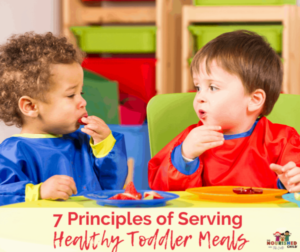6 Tips for the Toddler Who Can’t Sit Still
April 29, 2022
Toddlers are busy bodies. It’s hard for them to sit still and eat. Learn how to help your toddler sit still to eat.
Toddlers are curious creatures! And this is a big reason toddlers have a hard time sitting still when it’s time for meals. If you’ve got a toddler who won’t sit still, don’t fret. Part of this is nature’s way of helping the toddler achieve his developmental milestones, such as that for curiousity and exploration.
Translated: This is normal stuff!
But that doesn’t make it any less frustrating. The good news is that toddlers can focus. The bad news is their focus is brief.
In this article, you’ll learn some techniques for helping your toddler learn to sit still and eat, even if it may be for a brief time.

Tips for Getting Toddlers to Sit Still to Eat
While you cannot make a child eat, you can set up an environment that encourages attention and focus on the task at hand.
Remember, toddlers have a short attention span, and when they come to the table hungry, they tend to consume most of their calories early and in a short time.
1. Remove All Distractions
Yes, that means books, TV, dogs, and toys. These distractions make toddlers split their focus between eating and something else. In doing so, they can disconnect from their appetite cues. This means they may under-eat or overeat.
A distraction-free mealtime environment will help your toddler focus on eating.
2. Wait Until Mealtime is Ready
Toddlers get fidgety when they’re sitting around with nothing to do. Some parents put their toddler at the table or highchair before the meal is ready. And expect them to wait patiently!
Get the meal ready first, place it on the table, then bring your toddler into the chair.
Don’t waste precious time hoping your toddler will wait or behave while waiting. He’ll probably get bored and start to act up.
3. Keep Your Expectations Realistic
Sometimes we get caught up in a fantasy that our kid will sit and wait patiently for the meal to be placed in front of them, will excitedly dig in and eat everything you’ve offered, and pleasantly ask to be excused.
Wait. What??!
The reality is, toddlers sit for about 5-15 minutes for meals – tops. After that it’s a crap-shoot.
4. Sit With Your Toddler
I see this happening all the time. The toddler sits in a highchair, at the counter, or table all by himself. How boring!
Nobody – not you or I – wants to, or enjoys, eating alone.
It’s lonely and boring!
#truthfortoddlers
Not to mention, there’s no role modeling, conversation, or connection going on. A missed opportunity! Bring your toddler to the family meal table as early as possible. They’ll reap the emotional benefits of eating together.
5. Use a Timer
Toddlers are concrete thinkers. They think about things in black and white. Food tastes good or bad. There are bad guys and good guys. It’s part of their developmental makeup.
If your toddler won’t sit at the table for mealtime, try using a timer to show them how long you expect them to sit still and eat. This will also give them a challenge, and toddlers enjoy little games like this.
Make this fun, not punitive.
Set the timer low (like 2 minutes to start) and celebrate when your toddler makes it to the end. Gradually increase the time to a level that’s appropriate for toddlers (5-15 minutes).
6. Explain Why It’s Important to Sit Still and Eat
Toddlers are capable of learning why they should eat at mealtime and do well when you can explain it in toddler terms. Try something like:
“We have nap time, play time, bath time, and eat time. This is our eat time.”
Repeat yourself.
Repetition will help your toddler learn the concept and the language you choose to use. In the future, this is how your toddler will speak about, and adapt to, your routines.
Want More Help with the Toddler Who Can’t Sit Still?
Be sure to check out the courses, books and workshops we have in our TNC Shop.
You may also want to read:
Healthy Finger Foods for Toddlers
Toddler Portion Sizes: How Much to Feed a Tot
My Toddler Won’t Eat (A Step-by-Step Guide)










